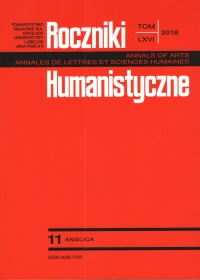Prosthetic Consonants and the Question of Nuclear Impact. Examples from Slavic Languages
Abstract
The article focuses on the problem of consonant prosthesis in a number of Slavic languages with w view to establishing both the context and trigger of the process. The phenomenon is analyzed from the perspective of Government Phonology (Kaye, Lowenstamm, and Vergnaud 1985, 1990; Charette 1991; Harris 1994; Gussmann 2007; Cyran 2003; Bloch-Rozmej 2008) which advocates a hierarchical model of phonological structure. The evidence examined here comes from Polish, Sorbian, Russian, Czech, Ukrainian and Belorussian. In all these languages consonant prosthesis is realized in the onset of the word-initial syllable. Thus, we also discuss the problem of the initial syllable prominence and the significance of a licensing relation that binds the members of the initial CV domain. It is proposed that the nucleus which determines the identity of the onset licensee is directly responsible for the excrescence of a prosthetic consonant, both prosodically and melodically. Hence, in order to fully understand the nature of the development, the analysis of the vowels involved in the process in terms of their segmental structure is needed. It will be demonstrated that the elements which build vocalic segments extend their domain of interpretation to affect the positions preceding them in the structure of the word-initial syllables. The problem of consonant prosthesis will be examined as an instantiation of the cross-linguistic tendency to strengthen segments in word-initial contexts.
References
Anderson, Stephen R. 1982. “The analysis of French schwa: or, how to get something for nothing.” Language 58: 534–573. https://doi.org/10.2307/413848.
Barnes, Jeffrey. 2003. “Initial-Syllable Prominence: What is it and where does it come from?” Paper presented at MIT Phonology Circle, May 2, 2003.
Beckman, Jill N. 1998. Positional Faithfulness. Ph.D. dissertation. University of Massachusetts, Amherst.
Byrd, Dani. 2000. “Articulatory vowel lengthening and coordination at phrasal junctures.” Phonetica 57: 3–16. https://doi.org/10.1159/000028456.
Biedrzycki, Leszek. 1963. “Fonologiczna Interpretacja Polskich Głosek Nosowych.” Biuletyn Polskiego Towarzystwa Językoznawczego 22, 25–45.
Bloch–Rozmej, Anna. 1997. “Nasal Vowels in Polish.” In Jacek Fisiak (ed.). Papers and Studies in Contrastive Linguistics. 32, 81–103. Poznań: Wydawnictwo NAKOM.
Bloch-Rozmej, Anna. 2008. Melody in Government Phonology. Lublin: Wydawnictwo KUL.
Charette, Monik. 1988. Some constraints on governing relations in phonology. Ph.D. dissertation, McGill University.
Charette, Monik. 1991. Conditions on Phonological Government. Cambridge: Cambridge University Press.
Cho, Taehong, and Sun-Ah Jun.2000. “Domain-initial strengthening as enhancement of laryngeal features: aerodynamic evidence from Korean.” UCLA Working Papers in Phonetics 99: 57–79.
Cyran, Eugeniusz. 2003/2010. Complexity scales and licensing strength in phonology. Lublin: Wydawnictwo KUL, Mouton de Gruyter.
Czekman, Walery, and Elżbieta Smułkowa. 1988. Fonetyka i fonologia języka białoruskiego z elementami fonetyki i fonologii ogólnej. Warszawa: Państwowe Wydawnictwo Naukowe.
Dalewska-Greń, Hanna. 2002. Języki słowiańskie. Warszawa: Wydawnictwo Naukowe PWN.
Dilley, Laura, Stefanie Shattuck-Huffnagel, and Mari Ostendorf. 1996. “Glottalization of word-initial vowels as a function of prosodic structure.” Journal of Phonetics 24: 423-444. https://doi.org/10.1006/jpho.1996.0023.
Doroszewski, Witold. 1963. Podstawy Gramatyki Polskiej. Warszawa: Państwowe Wydawnictwo Naukowe.
Fougeron, Cécile, and Patricia A. Keating. 1996. “Articulatory strengthening in prosodic domain-initial position.” UCLA Working Papers in Phonetics 92: 61–87. https://doi.org/10.1006/jpho.2001.0131
Gussmann, Edmund. 1974. “Nasality in Polish and English.” Papers and Studies in Contrastive Linguistics 2: 105–122.
Gussmann, Edmund. 1980. Studies in Abstract Phonology. Cambridge, Mass.: MIT Press.
Gussmann, Edmund. 2007. The phonology of Polish. Oxford: Oxford University Press.
Harris, John. 1994. English Sound Structure. Oxford: Blackwell.
Kaye, Jonathan, Jean Lowenstamm, and Jean-Roger Vergnaud. 1985. “The internal structure of phonological elements: a theory of charm and government.” Phonology Yearbook 2: 305–328. https://doi.org/10.1017/S0952675700000476.
Kaye, Jonathan, Jean Lowenstamm, and Jean-Roger Vergnaud. 1990. “Constituent structure and government in phonology.” Phonology 7: 193–231. https://doi.org/10.1017/S0952675700001184.
Laskowski, Roman. 1975. Studia nad morfologią współczesnego języka polskiego. Wrocław: Ossolineum.
PGURM. 1978. Брицин, Михайло Якимович, Михайло Андрійович Жовтобрюх, Анатолий Васильевич Майборода [Britsin, Mikhail Yakimovich, Mikhail Andreyevich Zhovtotbryuh, and Anatoly Vasilyevich Mayboroda.]. Порівняльна граматика української і російської мов [Porivnyalʹna hramatyka ukrayinsʹkoyi i rosiysʹkoyi mov]. Київ: Вища школа [Kyyiv: Vyshcha shkola].
Rubach, Jerzy. 1984. Cyclic and Lexical Phonology: the Structure of Polish. Dordrecht: Foris.
Smith, Jennifer. 2002. Phonological augmentation in prominent positions. Ph.D. dissertation. University of Massachusetts, Amherst.
Stieber, Zdzisław. 1979. Zarys gramatyki porównawczej języków słowiańskich. Warszawa: Państwowe Wydawnictwo Naukowe.
Turk, Alice E., and Stefanie Shattuck-Hufnagel. 2000. “Word-boundary-related duration patterns in English.” Journal of Phonetics 28: 397-440. https://doi.org/10.1006/jpho.2000.0123.
Copyright (c) 2018 Roczniki Humanistyczne

This work is licensed under a Creative Commons Attribution-NonCommercial-NoDerivatives 4.0 International License.





